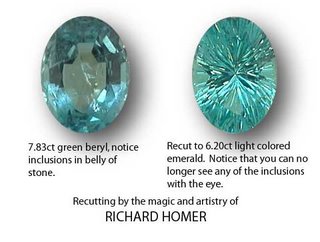
What we are looking for when we buy colored gems to wear in jewelry is beauty. The color itself can provide much of the beauty, but cutting will definitely add, or detract from that beauty. As you can easily see in this amethyst, the color is okay, but the cutting makes absolutely no use of the color. It is basically a lifeless lump of purple quartz, suitable for life in a fish tank, but not really for use in nice jewelry.
Here is a great example of what can be done with good use of cutting.

This "okay" light green beryl (the gem family that both aquamarine and emerald are found in) is transformed from merely pretty to extraordinary by the recutting artistry of Richard Homer. I think it is interesting to note that the cutting affects not only the sparkle and pizzas of the stone, but the eyes perceived color. Because the stone is now well cut the light is traveling through the stone and absorbing more light. This results in a prettier and more saturated color, even in the lighter stones. Here is a sapphire that we chose NOT to recut with the unique concave faceting that Richard Specializes in because it is already so saturate that to further saturate the stone might tip it over from its already incredible color to a stone that now appears too dark.

This 5 carat plus sapphire is already magnificent and although we did repolish away about a carat of it when we bought it, we went with the traditional flat faceting that would enhance the look of the gem, without the complete remake that might actually have lowered the value of the gem if it became too dark appearing. (The stone is not quite as dark as shown, sapphires do NOT like to share their beauty through photographs. It took a professional photographer to get this close to its actual beauty, a price well worth spending to be able to have this gem always in my photo gallery after it is sold.)
In short, what you should look for when buying a faceted colored gem, whether it be ruby, sapphire, emerald, aquamarine, amethyst or any other colored gem is how well did the cutter maximize the beauty of the gem. Did some native cutter slap a few facets on to make the edges sparkle and leave the center dull and open, or did a master play with the angles and facets to make the stone really sing and dance in the hearts of the viewers?
I will leave you with this traditionally faceted blue topaz, a very inexpensive stone according to most, that was tweaked with a little magic to result in this exquisite snowflake that is created by frosting the facet edges of the crown (top) of the gem. Even with the cost of the custom cutting this was a relatively inexpensive topaz and with the custom hand made mounting made a wonderful gift for a lucky lady a Christmas or two ago.

That's it for today, enjoy!
Wink
No comments:
Post a Comment